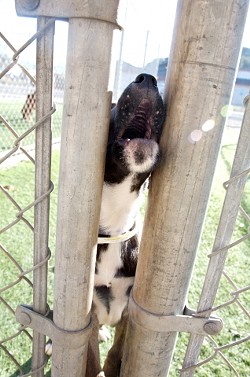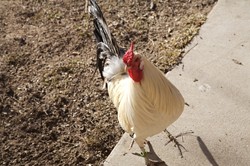Beyond the trial
Its alleged disgrace became her defense, but could conditions at Animal Services excuse Cynthia Walsh and her collection of dogs, cats, and more?
By Patrick M. Klemz[{
"name": "Ad - Medium Rectangle CC01 - 300x250",
"id": "AdMediumRectangleCC01300x250",
"class": "inlineCenter",
"insertPoint": "8",
"component": "2963441",
"requiredCountToDisplay": "12"
},{
"name": "Ad - Medium Rectangle LC01 - 300x250",
"id": "AdMediumRectangleCC01300x250",
"class": "inlineCenter",
"insertPoint": "18",
"component": "2963441",
"requiredCountToDisplay": "22"
},{
"name": "Ad - Medium Rectangle LC09 - 300x250",
"id": "AdMediumRectangleLC09300x250",
"class": "inlineCenter",
"insertPoint": "28",
"component": "3252660",
"requiredCountToDisplay": "32"
}]
Up the Cabrillo Highway from the government seat, the men and women of the San Luis Obispo County Sheriff's Department occupy a spartan complex in the shadow of Cerro Romauldo. Near the inlet of this frontage of bunkers, storage garages, and office buildings exists a small facility, easy enough to miss if not for the chorus of barks and yelps from the canine population inside.
In the final weeks of 2006, the Sheriff's Division of Animal
# Services and the shelter it maintains became the center of outside cacophony as 12 jurors deliberated on the fate of an Edna Valley woman charged in one of the grandest animal cruelty cases in regional history.Only on occasion does a proceeding come off as thoroughly and consistently contentious as that of media-labeled animal hoarder Cynthia Walsh. The year-long trial of the 57-year-old local revolutionized more times than sub-Saharan Africa. From its beginnings on a Sheriff's Department press release in December 2005 to its possible conclusion on Dec. 27, 2006, the only constant in the Walsh affair was the ever-present element of public interest.
Rarely does one encounter such an outwardly facile case: a woman and more than 100 animals crammed into a tiny house, officer reports cataloging filthy conditions, dead dogs occupying iceboxes, and a reported history of the defendant stiffing veterinary clinics. Statements from animal rights group PETA, screaming for justice, only sealed the deal, and the public condemnation of Walsh became record.
On the other hand, rarely are the familiar declarations of the defendant's innocence so voluminous and reputable.
A confusing mess of jury troubles and extensive deliberation provided an appropriate pseudo finale to the proceedings, with a three-part conviction for misdemeanor charges and a hung jury on six felony counts. As of press time for this story, prosecutors continued to deliberate whether to retry Walsh on the graver abuse charges. If they do, deputy district attorneys must address the crux of attorney Ilan Funke-Bilu's defense: The animals seized on that December day ultimately remained better off with Walsh than in the hands of Animal Services.
Victims of scarcity
Inside the bowels of Animal Services, one discovers a facility staffed, operated, and largely managed by a crew of dedicated volunteers. On a recent Saturday, the shelter buzzed with activity as the crew prepared for a stream of potential adoptions. Helpers walked dogs around the lawn for prospective owners, stopping only to greet an excited canine or two as the animals finished the final leg of their daily walk.
# Jovial chatter about a pit bull named Danny illuminated the volunteers' level of involvement in the development of the animals.
"You don't want to get too attached," one volunteer cautioned soberly, "because pretty soon you'll have seven."
Equally sobering were the signs of a group of people fighting a losing battle with finite resources.
A frigid dawn draft permeated the building and swept through its stone corridors. Heating systems along the ceiling offered little relief. Early in the morning, feces and urine filled the cages and, by day's end, food and water dishes sat empty something one visibly annoyed shelter helper called "nothing unusual."
Complaints from local veterinarians and private shelter managers regarding animal health appeared well-founded. Some dogs looked to be suffering from lack of exercise and others, so utterly morose as to seem sick. The cats, quite often, proved worse off. North Coast humanitarian Diana Duncan described having to rescue batches of felines from the shelter in recent years to provide them with adequate medical care.
A shortage of hands proved to be the culprit at every turn the county's skeleton staff merely complemented a crew of volunteers who valiantly contend with full-time lives. The day's absence of Dr. Anderson, who serves as both staff veterinarian and head of the division office, seemed nothing unusual. One woman claimed that, after coming in to the shelter roughly three to five days a week since September, she had still never seen the director.
"You can walk in there at any time and see that the animals are sick," another volunteer said. "Especially when the trial was going on, there were two or three cats that were put to sleep because nobody was taking care of them, because the vet (Anderson) wasn't there."
The director admitted that the on-site veterinary resources often fall short of the animals' needs, but the facility employs outside clinics rather than provide substandard care.
# "If it's an immediately pressing situation, [staff] can take it to a vet to get it attended to," said Anderson, who mentioned that two animals were outsourced to local clinics earlier the week of Jan. 8.
Still, critics maintain that the facility lacks the personnel to even identify and prioritize sick animals in a timely fashion, resulting in the death of many creatures.
"Eric Anderson's job is one of the hardest in the world," said Diane Pohja, director of local advocacy group KindPlanet. "But, you know what? That's the biggest thing: He's not asking for more funding."
"We have a relatively extensive budget," Anderson countered, "but we also have a very extensive operation. Our budget really does support the physical expenditures."
Advocates also complained that the more arcane species of domesticated animals snakes, rabbits, horses, and even goats receive the least amount of attention and expertise. One of the few volunteers specializing in this group griped that resources fall shorter every season in meeting the growing demand. She described incidents of untreated malocclusion a dental disorder among rabbits where the incisors grow misaligned and animals regularly missexed by staff. In one case, the volunteer said, she found a cage bird in a milk crate feeding on chicken scratch.
Back in the dog kennels, a brief orientation served to outline basic shelter practices, but, more than anything else, stressed the overall goal of preparing the animals for a second chance. Each animal's card included a date that indicated its term of stay at the facility a depressing reality compounded by each frivolous drop-off.
"There's only two ways out of here," a volunteer lamented. "One way is adoption."
A towering steel crematorium behind the complex punctuates the other route.
Victims of justice
In a courtroom at the Monterey Street annex, television cameras flanked the exits as witnesses testified in the closing weeks of the Walsh case. Defense attorney Funke-Bilu sent up a cavalcade of volunteers, veterinarians, and humanitarians in an attempt to establish the animals' plight after the seizure. Local veterinarian Liz Bracken vividly described some of the purportedly foul conditions faced by the animals in county care and the damage she believed those conditions caused.
# From the defense table, Walsh teared up as Bracken recounted how one particular dog lost an eye.
Some of the testimony countered statements from Anderson and animal control officers, who echoed the less-than-benign reports of the unsanitary conditions documented at the time of seizure. Some of the testimony went after Anderson himself.
Character witness Donna Buckholtz testified to a situation involving her cat that she believed Anderson mishandled and lied to cover up. The matter went before the Veterinary Medical Board in 2001. After the Walsh verdict, she accused the director of lying under oath about the cause of the animal's death.
Files indicate that the clinic where Anderson worked at the time was cited and fined for mishandling radiograph records relevant to the case. Yet, Buckholtz also contended that the director misrepresented the cause of her cat's death.
Anderson stood behind his diagnosis and treatment of the animal.
"It was a really sad situation where the cat died as a result of its condition," related the director, pointing out that the hospital, not he, was cited for the procedural faux pas. "There was a complaint and the board found no indication of any impropriety."
The trial also shepherded several disturbing accounts involving the division into public view, the most insidious of which involved two Honor Farm trustees reportedly swinging kittens around on a catchpole in mid-December. Tales of the incident, still unverified, emerged in the heat of the trial and described a volunteer stumbling upon the scene during off-hours cage cleaning.
The first-hand witness to the reported event declined to go on record.
Sgt. Brian Hascall, spokesman for the Sheriff's Department, said that investigators found nothing to lend veracity to the complaint and only learned of it when a television crew arrived at headquarters with an inquiry.
"We went back a month and no complaints were filed," Hascall said. "Obviously, if individuals at the Honor Farm were mistreating animals, they would be removed from that duty."
The Sheriff's Honor Farm employs low-risk county inmates to provide general labor at the shelter, among other functions. The trustees spend their nights in dormitory-style barracks adjacent to the shelter and those volunteering for kennel duty work under the supervision of Animal Services officers (of which, on a busy Saturday, New Times counted two).
"The prisoners mostly just do their job, but they're in jail for a reason," said one volunteer.
# However, even the alleged catchpole event was extraneous in the judicial scope. The jury's concern with the affairs of Animal Services dealt solely with the welfare of Walsh's animals while they were in the custody of the Sheriff's Department.
Though Anderson declined to talk with media during the trial, he told this publication in an earlier interview that the shelter had increased its staff by 200 percent to deal with the hefty influx of Walsh's animals. With standard boarding costs and the reported expense of dealing with what the director described as "general health problems characterizing neglect," the cost quickly ran into the thousands.
"With 83 dogs coming in at once, obviously it was a huge logistical problem," he later stated.
According to Anderson, the shelter is designed to handle about 45 dogs.
Several volunteers, one on the witness stand, challenged the extent or quality of care given to Walsh's animals in county care. This witness, Mary Paulson of Paso Robles, accused the division head of treating the seized animals like dope in an evidence locker. She described one spring day after the seizure when she had to gain permission to dry the Walsh dogs off after a vernal downpour. The animals, at the time, occupied shared outdoor kennels.
"They were not allowed out for walking or exercise or even just plain contact," Paulson initially complained in a letter to Sheriff Pat Hedges, dated April 21. "I was shocked when I saw their deplorable condition."
Anderson ascribed the happening to bureaucracy: In adherence to code dealing with the management of evidence, Walsh's animals had to be isolated and protected from outside tampering until as late as March. The director also contended that actions by the defense further delayed the adoption process.
"Several of the motions filed in court by the defense actually delayed us from placing the animals in the most appropriate evaluated homes," he said.
Victims of success
Several years ago, an acclaimed botanical essayist, the aptly-named Michael Pollan, scripted a masterful piece of ecological philosophy, titled the Botany of Desire. The study examines the inanimate consciousness of four plants and how they achieved unprecedented success by playing into various forms of human desire. He briefly draws a parallel to domesticated animals as well.
"There are 50 million dogs in America today, only ten thousand wolves," Pollan wrote. "If you could read the genome of the dog like a book, you would learn a great deal about who we are and what makes us tick."
Food, shelter, protection, and a level of medical service unknown to humans themselves until the 19th century all for a lick and the wag of a tail. It's quite a deal.
Yet, to capitalize on human desire is also to be subject to its whims, as segments of the Cal Poly student body remind shelter workers at the close of every academic year. In the Central Coast microclimate of animal management, animal advocates say, the real trouble began with a news report extolling the virtues of the shelter, printed toward the end of 2004.
"What happened is the shelter became a victim of its own success," activist Pohja explained. "People saw that coverage and got to thinking it was a no-kill shelter."
Lured by tales of such a place under the umbrella of public funding, scores of pet owners began dropping off their pets often old and sick animals rather than bear the expense of properly caring for them. Euthanasia rates boomed. Today, the Hwy. 1 facility regularly euthanizes its guests for space constraints alone, though, statistically not to the extent many claim, Anderson asserted.
"I'm always cautious to use the label 'no-kill,'" Anderson said. "It was a milestone our county achieved, and we maintained it for three calendar years. We were walking on a razor's edge for most of that time."
On the shelter consent form, the terms plainly state a need for volunteers to not contest the decisions of the director to cull the herd, though many volunteers cried out during the trial that treatable, adoptable animals were put down due to a lack of veterinary care.
Beyond the acrimony, the Walsh trial in particular highlighted what can take place when an already-taxed system is overrun because of a sudden catastrophic event. Nine months after the witness Paulson watched the Walsh dogs soaking in a spring rain, facility resources remain strained under normal conditions.
Info Box: Paws for a moment
To help shelter staff and volunteers better serve the growing number of animals in their charge, more hands are needed. Contact the volunteer office at 781-4413 to find out more about opportunities at Animal Services.
Staff writer Patrick M. Klemz can be reached at [email protected].
Latest in News
Readers also liked…
-

Coast Unified teachers upset over new position's salary and qualifications
Oct 20, 2022 -

SLO police identify alleged driver who hit and killed couple
Dec 22, 2022 -

When the levee breaks: Oceano residents, county officials walk a tightrope of regulations to manage Arroyo Grande Creek, which some say led to the levee's failure in January
May 18, 2023












